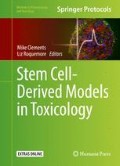Abstract
Measurement of contractility using impedance is a novel method for gaining information about a drug candidate’s potential to disturb cardiac cell contraction. The impedance signal is recorded from a monolayer of cardiac cells, most commonly derived from human-induced pluripotent stem cells (hiPSCs), which are becoming an attractive model for safety testing, especially in the light of the Comprehensive In Vitro Proarrhythmia Assay (CiPA) initiative introduced in 2013. The goal of this initiative is, in part, to standardize assays, targets, and cell types but also to evaluate the potential of new technologies, in this context, such as impedance. The CardioExcyte 96 is a hybrid system that combines the impedance readout (a measure of cell contractility) with extracellular field potential (EFP) recordings. This chapter focuses on cell handling of hiPSC cardiomyocytes (CMs) and the short- and long-term investigation into pharmacological effects of a wide range of pharmacological agents, including flecainide, nifedipine, isoproterenol, and E4031 using the CardioExcyte 96.
Access this chapter
Tax calculation will be finalised at checkout
Purchases are for personal use only
References
Connolly P, Clark P, Curtis ASG et al (1990) An extracellular microelectrode array for monitoring electrogenic cells in culture. Biosens Bioelectron 5:223–234. doi:10.1016/0956-5663(90)80011-2
Thomas C Jr, Springer P, Loeb G et al (1972) A miniature microelectrode array to monitor the bioelectric activity of cultured cells. Exp Cell Res 74:61–66. doi:10.1016/0014-4827(72)90481-8
Gross GW, Williams AN, Lucas JH (1982) Recording of spontaneous activity with photoetched microelectrode surfaces from mouse spinal neurons in culture. J Neurosci Methods 5:13–22. doi:10.1016/0165-0270(82)90046-2
Borkholder DA, Bao J, Maluf NI et al (1997) Microelectrode arrays for stimulation of neural slice preparations. J Neurosci Methods 77:61–66. doi:10.1016/S0165-0270(97)00112-X
Regehr WG, Pine J, Cohan CS et al (1989) Sealing cultured invertebrate neurons to embedded dish electrodes facilitates long-term stimulation and recording. J Neurosci Methods 30:91–106
Spira ME, Hai A (2013) Multi-electrode array technologies for neuroscience and cardiology. Nat Nanotechnol 8:83–94. doi:10.1038/nnano.2012.265
Harris K, Aylott M, Cui Y et al (2013) Comparison of electrophysiological data from human-induced pluripotent stem cell-derived cardiomyocytes to functional preclinical safety assays. Toxicol Sci 134:412–426. doi:10.1093/toxsci/kft113
Clements M, Thomas N (2014) High-throughput multi-parameter profiling of electrophysiological drug effects in human embryonic stem cell derived cardiomyocytes using multi-electrode arrays. Toxicol Sci 140:445–461. doi:10.1093/toxsci/kfu084
Clements M, Millar V, Williams A, Kalinka S (2015) Bridging functional and structural cardiotoxicity assays using human embryonic stem-cell derived cardiomyocytes for a more comprehensive risk assessment. Toxicol Sci 148:241–260. doi:10.1093/toxsci/kfv180
Xi B, Wang T, Li N et al (2011) Functional cardiotoxicity profiling and screening using the xCELLigence RTCA cardio system. J Lab Autom 16:415–421. doi:10.1016/j.jala.2011.09.002
Guo L, Abrams R, Babiarz JE et al (2011) Estimating the risk of drug-induced proarrhythmia using human induced pluripotent stem cell derived cardiomyocytes. Toxicol Sci 123:281–289. doi:10.1093/toxsci/kfr158
Doerr L, Thomas U, Guinot DR et al (2015) New easy-to-use hybrid system for extracellular potential and impedance recordings. J Lab Autom 20:175–188. doi:10.1177/2211068214562832
Abassi YA, Xi B, Li N et al (2012) Dynamic monitoring of beating periodicity of stem cell-derived cardiomyocytes as a predictive tool for preclinical safety assessment. Br J Pharmacol 165:1424–1441. doi:10.1111/j.1476-5381.2011.01623.x
Peters MF, Lamore SD, Guo L et al (2014) Human stem cell-derived cardiomyocytes in cellular impedance assays: bringing cardiotoxicity screening to the front line. Cardiovasc Toxicol 15:127–139. doi:10.1007/s12012-014-9268-9
Lamore SD, Scott CW, Peters MF (2015) Cardiomyocyte Impedance Assays. In: Assay Guidance Manual [Internet]. (Sittampalam GS, Coussens NP, Nelson H, Arkin M, Auld D, Austin C, Bejcek B, Glicksman M, Inglese J, Iversen PW, Li Z, McGee J, McManus O, Minor L, Napper A, Peltier JM, Riss T, Trask OJ Jr., Weidner J. Eds). Bethesda (MD): Eli Lilly & Company and the National Center for Advancing Translational Sciences; 2004–2015 Feb 25
Chan Y-C, Ting S, Lee Y-K et al (2013) Electrical stimulation promotes maturation of cardiomyocytes derived from human embryonic stem cells. J Cardiovasc Transl Res 6:989–999. doi:10.1007/s12265-013-9510-z
Shen JB, Jiang B, Pappano AJ (2000) Comparison of L-type calcium channel blockade by nifedipine and/or cadmium in guinea pig ventricular myocytes. J Pharmacol Exp Ther 294:562–570
Zhou Z, Gong Q, Ye B et al (1998) Properties of HERG channels stably expressed in HEK 293 cells studied at physiological temperature. Biophys J 74:230–241. doi:10.1016/S0006-3495(98)77782-3
Liu S, Rasmusson RL, Campbell DL et al (1996) Activation and inactivation kinetics of an E-4031-sensitive current from single ferret atrial myocytes. Biophys J 70:2704–2715. doi:10.1016/S0006-3495(96)79840-5
Sager PT, Gintant G, Turner JR et al (2014) Rechanneling the cardiac proarrhythmia safety paradigm: a meeting report from the Cardiac Safety Research Consortium. Am Heart J 167:292–300. doi:10.1016/j.ahj.2013.11.004
Fermini B, Hancox JC, Abi-Gerges N et al (2015) A new perspective in the field of cardiac safety testing through the comprehensive in vitro proarrhythmia assay paradigm. J Biomol Screen. doi:10.1177/1087057115594589
Acknowledgments
We thank Cellular Dynamics International (CDI), Madison, Wisconsin, for the collaboration and for providing us with cardiomyocytes (iCell cardiomyocytes). We also thank Axiogenesis AG, Cologne, Germany, for the collaboration and for providing us with cardiomyocytes (Cor.4U). We also thank Pluriomics for the collaboration and for providing us with the Pluricytes.
The authors disclose receipt of the following financial support for the research, authorship, and/or publication of this article: The work presented here was funded in part by the Bayerische Forschungsstiftung (BayFor, Grant AZ-1036-12) and by the Bundesministerium für Bildung und Forschung (BMBF, Grant 01QE1502).
Author information
Authors and Affiliations
Corresponding author
Editor information
Editors and Affiliations
Rights and permissions
Copyright information
© 2017 Springer Science+Business Media New York
About this protocol
Cite this protocol
Obergrussberger, A. et al. (2017). Combined Impedance and Extracellular Field Potential Recordings from Human Stem Cell-Derived Cardiomyocytes. In: Clements, M., Roquemore, L. (eds) Stem Cell-Derived Models in Toxicology. Methods in Pharmacology and Toxicology. Humana Press, New York, NY. https://doi.org/10.1007/978-1-4939-6661-5_10
Download citation
DOI: https://doi.org/10.1007/978-1-4939-6661-5_10
Published:
Publisher Name: Humana Press, New York, NY
Print ISBN: 978-1-4939-6659-2
Online ISBN: 978-1-4939-6661-5
eBook Packages: Springer Protocols

